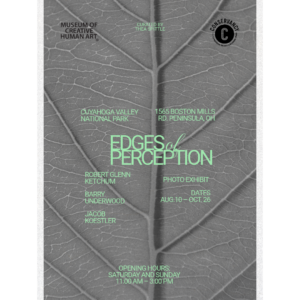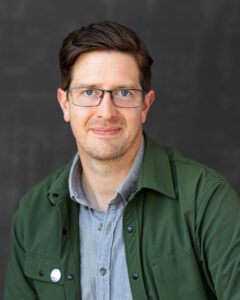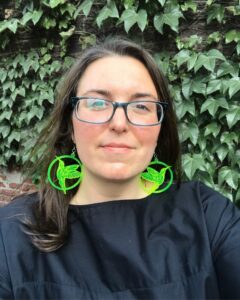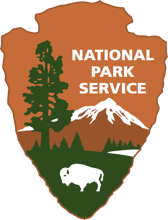The Gallery

Edges of Perception
From 1986 to 1988, photographer Robert Glenn Ketchum documented the Cuyahoga Valley National Recreation Area (now Cuyahoga Valley National Park). The images, featured in Overlooked in America: The Success and Failure of Federal Land Management, became a metaphor for larger themes behind the park’s existence. Through this work, Ketchum advocated for environmental conservation and the protection of overlooked landscapes and ecosystems. In celebration of the park’s 50th anniversary, the Akron Art Museum is exhibiting a collection of Ketchum’s work from this project. The exhibition, Ordinary Miracles: Robert Glenn Ketchum’s Photographs of Cuyahoga Valley National Park, is open Aug. 10 – Jan. 25, 2026.
Edges of Perception—created in partnership with the Museum of Creative Human Art—expands on the Akron Art Museum’s exhibition of Ketchum’s photographs by placing two Northeast Ohio photographers, Barry Underwood and Jacob Koestler, in conversation with his critically acclaimed project. Their recorded landscapes act as another kind of storytelling, one that pushes our sight lines to travel wider and closer to the horizon. As a group, these three photographers share an authentic curiosity for how to represent a moment in time within the edges of a frame.
Exhibit On Display: Aug. 10 – Oct. 26, 2025
Gallery Location: 1565 Boston Mills Rd., Peninsula, OH
(Parking is available at the Boston Mill Visitor Center at 6947 Riverview Rd.
or Boston Trailhead at 1508 Boston Mills Rd.)
Hours: Saturday – Sunday | 11:00 am – 3:00 pm
About the Artists
Robert Glenn Ketchum
Over the last 40 years, Robert Glenn Ketchum’s imagery, writing, exhibitions, numerous books and personal activism have helped to define photography’s successful use in conservation advocacy. At the same time, Ketchum’s decades of color printing are one of the most unique bodies of work in contemporary color photography, and the textile translations of his photographs created in China since the early 1980’s are among the most beautiful and complex textiles in contemporary art.
Ketchum was named by Audubon magazine as one of the 100 people “who shaped the environmental movement of the 20th Century.” American Photo magazine listed him one of the 100 most important people in contemporary photography in the 1990’s, and then in 2010, named him 5th in their very select American Masters series. Henri Cartier-Bresson, Richard Avedon, Helmut Newton, and Annie Leibovitz, were the four previously recognized. Recent work in new technologies has further prompted Digital Photo Pro magazine to name Ketchum one of the new digital masters.
Ketchum’s work is in numerous collections including the Museum of Modern Art (NY), The Metropolitan Museum of Art (NY), The Los Angeles County Museum of Art, the High Museum (GA), and the Houston Museum of Fine Art (TX). Large study collections (over 100 images) have been established at the Huntington Library, Museums and Garden (CA), and the Amon Carter Museum (TX).
Barry Underwood
Barry Underwood’s creative practice stands at the intersection of staged photography, land art, and minimalist sculpture. His work illuminates environments that hold rich ecological and cultural histories and are sites of destructive human behavior. By building and photographing sculptures of light, Underwood elucidates the ways humans intervene in the natural environment while highlighting how society normalizes these exploitations. His work makes visible the cultural constructs of wilderness and, by extension, the environmental issues related to human use and abuse of natural resources.
Each of Underwood’s photographs begins with many hours of location search, talking with community members, learning the place’s ecological and social histories, and studying satellite imagery. He also visits tourist sites and science centers to gather documented narratives while spending considerable time in the environment, watching, listening, and exploring. His goal is to learn how humans, past, and present, engage with a particular site and, more broadly, the land itself. Through these investigations, Underwood has come to understand that landscape contains rich layers of information, providing for different types of storytelling.
Jacob Koestler

Jacob Koestler is a visual artist from Johnstown, Pennsylvania. He holds an MFA from the Photography and Integrated Media program at Ohio University. His practice includes non-fiction film, photography, sound design, and multimedia installation. Koestler is also a co-founder of Blurry Pictures, an award-winning collaborative project that produces documentaries, books and other printed matter. Koestler’s artwork has been exhibited and published throughout the United States and internationally. He currently lives in Cleveland, Ohio and is a studio manager and lecturer at Oberlin College.
Exhibition Curator
Thea Spittle

Thea Spittle (she/her) is an independent curator and writer based in Akron, Ohio. She collaborates alongside artists to produce exhibitions, publications and public programs for the greater Northeast Ohio community. Spittle holds a Master of Arts in Curatorial Studies from the Center for Curatorial Studies at Bard College, Annandale-on-Hudson, New York and a Bachelor of Arts in Art History and Spanish from Hamilton College, Clinton, New York. Her first curatorial project, the sunroom, was in a Cleveland Heights home, and showcased site-specific installations throughout the home and its yard. She served as co-curator for CAN Triennial 2022 producing exhibitions at Zygote Press, Morgan Paper Conservancy and artNEO. She currently co-directs Gallery 2602 with Deidre McPherson, a roaming exhibition and public programming platform situated within community spaces. She has written essays for Cleveland Institute of Art, CAN Journal and Gallery 2602 and moderated the panel discussion Who Curates Contemporary Art? at Cleveland Museum of Art.
About the Museum of Creative Human Art
The Museum of Creative Human Art (MOCHA) uses a character-based approach to bridge creative expression with education and personal development. They provide a space for underserved youth to learn, connect, create, and share. At the heart of MOCHA’s work is a focus on cultivating conscientiousness, moral agency, core values, and the social attitudes necessary for individuals to make meaningful contributions to society.
MOCHA encourages young artists to produce independently, but also reinforces shared imaginative exploration to spark fresh ideas and works of art. They aim to equip young, underserved artists with the tools to express their thoughts, emotions, and views through various art forms.
The Arts in the Park Initiative is generously supported by the following individuals and organizations:

Richard and Jean Hoffman

Janice Matteucci & Parnell Tillotson
Thomas Merryweather






